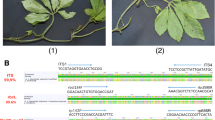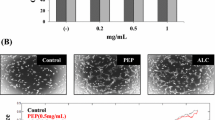Abstract
Insulin/insulin-like growth factor (IGF)-like signaling plays important roles in the aging processes of various animals. However, little is known about this signaling in rotifers, which have been used as a model animal in aging studies. Here we report that the aqueous extracts of the rotifer Brachionus plicatilis show activity similar to that of insulin/IGFs. Rotifers were cultured under four different feeding regimens (fed, starved for about ten days, or re-fed for 30 and 120 min after starvation), and then their aqueous extracts were added to culture media of rat L6 myoblasts. Treatment with these extracts increased the phosphorylation levels of mitogen-activated protein kinase (MAPK)/extracellular signal-regulated kinase (ERK) and two Akt substrates of approximately 48 and 60 kDa, and these phosphorylations were diminished when cells were preincubated with specific inhibitors of their upstream kinases (MAPK/ERK kinase and phosphoinositide 3-kinase, respectively). Furthermore, the extracts from fed rotifers provoked higher phosphorylation levels of MAPK/ERK and Akt substrates than the extract from starved rotifers, suggesting that the production of substance(s) with insulin/IGF-like activity is stimulated upon feeding in the rotifer.





Similar content being viewed by others
References
Saltiel AR, Kahn CR (2001) Insulin signalling and the regulation of glucose and lipid metabolism. Nature 414:799–806
Taniguchi CM, Emanuelli B, Kahn CR (2006) Critical nodes in signalling pathways: insights into insulin action. Nat Rev Mol Cell Biol 7:85–96
Zhang W, Liu HT (2002) MAPK signal pathways in the regulation of cell proliferation in mammalian cells. Cell Res 12:9–18
Sanchez-Margálet V, Goldfine ID, Vlahos CJ, Sung CK (1994) Role of phosphatidylinositol-3-kinase in insulin receptor signaling: studies with inhibitor, LY294002. Biochem Biophys Res Commun 204:446–452
Kenyon C, Chang J, Gensch E, Rudner A, Tabtiang R (1993) A C. elegans mutant that lives twice as long as wild type. Nature 366:461–464
Tatar M, Kopelman A, Epstein D, Tu MP, Yin CM, Garofalo RS (2001) A mutant Drosophila insulin receptor homolog that extends life-span and impairs neuroendocrine function. Science 292:107–110
Blüher M, Kahn BB, Kahn CR (2003) Extended longevity in mice lacking the insulin receptor in adipose tissue. Science 299:572–574
Holzenberger M, Dupont J, Ducos B, Leneuve P, Géloën A, Even PC, Cervera P, Le Bouc Y (2003) IGF-1 receptor regulates lifespan and resistance to oxidative stress in mice. Nature 421:182–187
Bishop NA, Guarente L (2007) Genetic links between diet and lifespan: shared mechanisms from yeast to humans. Nat Rev Genet 8:835–844
Houthoofd K, Braeckman BP, Johnson TE, Vanfleteren JR (2003) Life extension via dietary restriction is independent of the Ins/IGF-1 signalling pathway in Caenorhabditis elegans. Exp Gerontol 38:947–954
Polonsky KS, Given BD, Hirsch LJ, Tillil H, Shapiro ET, Beebe C, Frank BH, Galloway JA, Van Cauter E (1988) Abnormal patterns of insulin-secretion in non-insulin-dependent diabetes-mellitus. New Engl J Med 318:1231–1239
Clemmons DR, Klibanski A, Underwood LE, McArthur JW, Ridgway EC, Beitins IZ, Van Wyk JJ (1981) Reduction of plasma-immunoreactive somatomedin C during fasting in humans. J Clin Endocrinol Metab 53:1247–1250
Isley WL, Underwood LE, Clemmons DR (1983) Dietary components that regulate serum somatomedin-C concentrations in humans. J Clin Invest 71:175–182
Thissen JP, Ketelslegers JM, Underwood LE (1994) Nutritional regulation of the insulin-like growth factors. Endocr Rev 15:80–101
Kim HJ, Jung KJ, Yu BP, Cho CG, Chung HY (2002) Influence of aging and calorie restriction on MAPKs activity in rat kidney. Exp Gerontol 37:1041–1053
Xie L, Jiang Y, Ouyang P, Chen J, Doan H, Herndon B, Sylvester JE, Zhang K, Molteni A, Reichle M, Zhang R, Haub MD, Baybutt RC, Wang W (2007) Effects of dietary calorie restriction or exercise on the PI3 K and Ras signaling pathways in the skin of mice. J Biol Chem 282:28025–28035
Nagasawa H, Kataoka H, Isogai A, Tamura S, Suzuki A, Ishizaki H, Mizoguchi A, Fujiwara Y, Suzuki A (1984) Amino-terminal amino acid sequence of the silkworm prothoracicotropic hormone: homology with insulin. Science 226:1344–1345
Wu Q, Brown MR (2006) Signaling and function of insulin-like peptides in insects. Annu Rev Entomol 51:1–24
Smit AB, Van Kesteren RE, Li KW, Van Minnen J, Spijker S, Van Heerikhuizen H, Geraerts WPM (1998) Towards understanding the role of insulin in the brain: lessons from insulin-related signaling systems in the invertebrate brain. Prog Neurobiol 54:35–54
Floyd PD, Li L, Rubakhin SS, Sweedler JV, Horn CC, Kupfermann I, Alexeeva VY, Ellis TA, Dembrow NC, Weiss KR, Vilim FS (1999) Insulin prohormone processing, distribution, and relation to metabolism in Aplysia californica. J Neurosci 19:7732–7741
Pierce SB, Costa M, Wisotzkey R, Devadhar S, Homburger SA, Buchman AR, Ferguson KC, Heller J, Platt DM, Pasquinelli AA, Liu LX, Doberstein SK, Ruvkun G (2001) Regulation of DAF-2 receptor signaling by human insulin and ins-1, a member of the unusually large and diverse C. elegans insulin gene family. Genes Dev 15:672–686
Chan SJ, Cao QP, Steiner DF (1990) Evolution of the insulin superfamily: cloning of a hybrid insulin/insulin-like growth factor cDNA from amphioxus. Proc Natl Acad Sci USA 87:9319–9323
Ikeya T, Galic M, Belawat P, Nairz K, Hafen E (2002) Nutrient-dependent expression of insulin-like peptides from neuroendocrine cells in the CNS contributes to growth regulation in Drosophila. Curr Biol 12:1293–1300
Masumura M, Satake S, Saegusa H, Mizoguchi A (2000) Glucose stimulates the release of bombyxin, an insulin-related peptide of the silkworm Bombyx mori. Gen Comp Endocrinol 118:393–399
Enesco HE (1993) Rotifers in aging research: use of rotifers to test various theories of aging. Hydrobiologia 255:59–70
Luciani A, Chassé JL, Clément P (1983) Aging in Brachionus plicatilis: the evolution of swimming as a function of age at two different calcium concentrations. Hydrobiologia 104:141–146
Serra M, Carmona MJ, Miracle MR (1994) Survival analysis of three clones of Brachionus plicatilis (Rotifera). Hydrobiologia 277:97–105
Yoshinaga T, Hagiwara A, Tsukamoto K (2000) Effect of periodical starvation on the life history of Brachionus plicatilis O. F. Müller (Rotifera): a possible strategy for population stability. J Exp Mar Biol Ecol 253:253–260
Ozaki Y, Kaneko G, Yanagawa Y, Watabe S (2010) Calorie restriction in the rotifer Brachionus plicatilis enhances hypoxia tolerance in association with the increased mRNA levels of glycolytic enzymes. Hydrobiologia 649:267–277
Kaneko G, Yoshinaga T, Yanagawa Y, Ozaki Y, Tsukamoto K, Watabe S (2011) Calorie restriction-induced maternal longevity is transmitted to their daughters in a rotifer. Funct Ecol 25:209–216
Kailasam M, Kaneko G, Oo AKS, Ozaki Y, Thirunavukkarasu AR, Watabe S (2011) Effects of calorie restriction on the expression of manganese superoxide dismutase and catalase under oxidative stress conditions in the rotifer Brachionus plicatilis. Fish Sci 77:403–409
Orr WC, Sohal RS (1994) Extension of life-span by overexpression of superoxide dismutase and catalase in Drosophila melanogaster. Science 263:1128–1130
Sun J, Folk D, Bradley TJ, Tower J (2002) Induced overexpression of mitochondrial Mn-superoxide dismutase extends the life span of adult Drosophila melanogaster. Genetics 161:661–672
Schriner SE, Linford NJ, Martin GM, Treuting P, Ogburn CE, Emond M, Coskun PE, Ladiges W, Wolf N, Van Remmen H, Wallace DC, Rabinovitch PS (2005) Extension of murine life span by overexpression of catalase targeted to mitochondria. Science 308:1909–1911
Murphy CT, McCarroll SA, Bargmann CI, Fraser A, Kamath RS, Ahringer J, Li H, Kenyon C (2003) Genes that act downstream of DAF-16 to influence the lifespan of Caenorhabditis elegans. Nature 424:277–284
Yoshinaga T, Kaneko G, Kinoshita S, Furukawa S, Tsukamoto K, Watabe S (2005) Insulin-like growth factor signaling pathway involved in regulating longevity of rotifers. Hydrobiologia 546:347–352
Yoshinaga T, Hagiwara A, Tsukamoto K (1999) Effect of conditioned media on the asexual reproduction of the monogonont rotifer Brachionus plicatilis O. F. Müller. Hydrobiologia 412:103–110
Yoshinaga T, Minegishi Y, Rumengan IFM, Kaneko G, Furukawa S, Yanagawa Y, Tsukamoto K, Watabe S (2004) Molecular phylogeny of the rotifers with two Indonesian Brachionus linages. Coast Mar Sci 29:45–56
Yoshinaga T, Hagiwara A, Tsukamoto K (2001) Why do rotifer populations present a typical sigmoid growth curve? Hydrobiologia 446:99–105
Verdone-Smith C, Enesco HE (1982) The effect of temperature and of dietary restriction on lifespan and reproduction in the rotifer Asplanchna brightwelli. Exp Gerontol 17:255–262
Kirk KL (2001) Dietary restriction and aging: comparative tests of evolutionary hypotheses. J Gerontol A Biol Sci Med Sci 56:B123–B129
Weithoff G (2007) Dietary restriction in two rotifer species: the effect of the length of food deprivation on life span and reproduction. Oecologia 153:303–308
Hua QX, Nakagawa SH, Wilken J, Ramos RR, Jia W, Bass J, Weiss MA (2003) A divergent INS protein in Caenorhabditis elegans structurally resembles human insulin and activates the human insulin receptor. Genes Dev 17:826–831
Gutiérrez J, Brandan E (2010) A novel mechanism of sequestering fibroblast growth factor 2 by glypican in lipid rafts, allowing skeletal muscle differentiation. Mol Cell Biol 30:1634–1649
Reddypalli S, Roll K, Lee HK, Lundell M, Barea-Rodriguez E, Wheeler EF (2005) p75NTR-mediated signaling promotes the survival of myoblasts and influences muscle strength. J Cell Physiol 204:819–829
Dajani OF, Meisdalen K, Guren TK, Aasrum M, Tveteraas IH, Lilleby P, Thoresen GE, Sandnes D, Christoffersen T (2008) Prostaglandin E2 upregulates EGF-stimulated signaling in mitogenic pathways involving Akt and ERK in hepatocytes. J Cell Physiol 214:371–380
Pozios KC, Ding J, Degger B, Upton Z, Duan C (2001) IGFs stimulate zebrafish cell proliferation by activating MAP kinase and PI3-kinase-signaling pathways. Am J Physiol Regul Integr Comp Physiol 280:R1230–R1239
Schlueter PJ, Peng G, Westerfield M, Duan C (2007) Insulin-like growth factor signaling regulates zebrafish embryonic growth and development by promoting cell survival and cell cycle progression. Cell Death Differ 14:1095–1105
Toyoshima Y, Monson C, Duan CM, Wu Y, Gao C, Yakar S, Sadler KC, LeRoith D (2008) The role of insulin receptor signaling in zebrafish embryogenesis. Endocrinology 149:5996–6005
Zhang H, Liu J, Li CR, Momen B, Kohanski RA, Pick L (2009) Deletion of Drosophila insulin-like peptides causes growth defects and metabolic abnormalities. Proc Natl Acad Sci USA 106:19617–19622
Grönke S, Clarke DF, Broughton S, Andrews TD, Partridge L (2010) Molecular evolution and functional characterization of Drosophila insulin-like peptides. PLoS Genet 6:e1000857
King CE (1967) Food, age, and dynamics of a laboratory population of rotifers. Ecology 48:111–128
Acknowledgments
This study was partly funded by a Grant-in-Aid for Scientific Research from the Japan Society for the Promotion of Science. We thank Professor A. Hagiwara, Graduate School of Science and Technology, Nagasaki University, Japan for kindly providing B. plicatilis (Ishikawa strain). Y. Ozaki was supported by Research Fellowships for Young Scientists from the Japan Society for the Promotion of Science.
Author information
Authors and Affiliations
Corresponding author
Rights and permissions
About this article
Cite this article
Ozaki, Y., Kaneko, G., Hakuno, F. et al. Insulin/insulin-like growth factor-like activity in the aqueous extracts of the rotifer Brachionus plicatilis . Fish Sci 79, 47–53 (2013). https://doi.org/10.1007/s12562-012-0570-9
Received:
Accepted:
Published:
Issue Date:
DOI: https://doi.org/10.1007/s12562-012-0570-9




